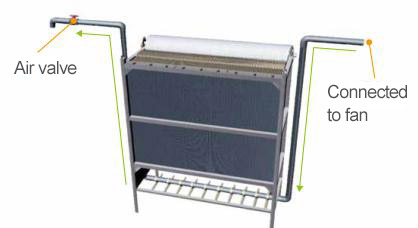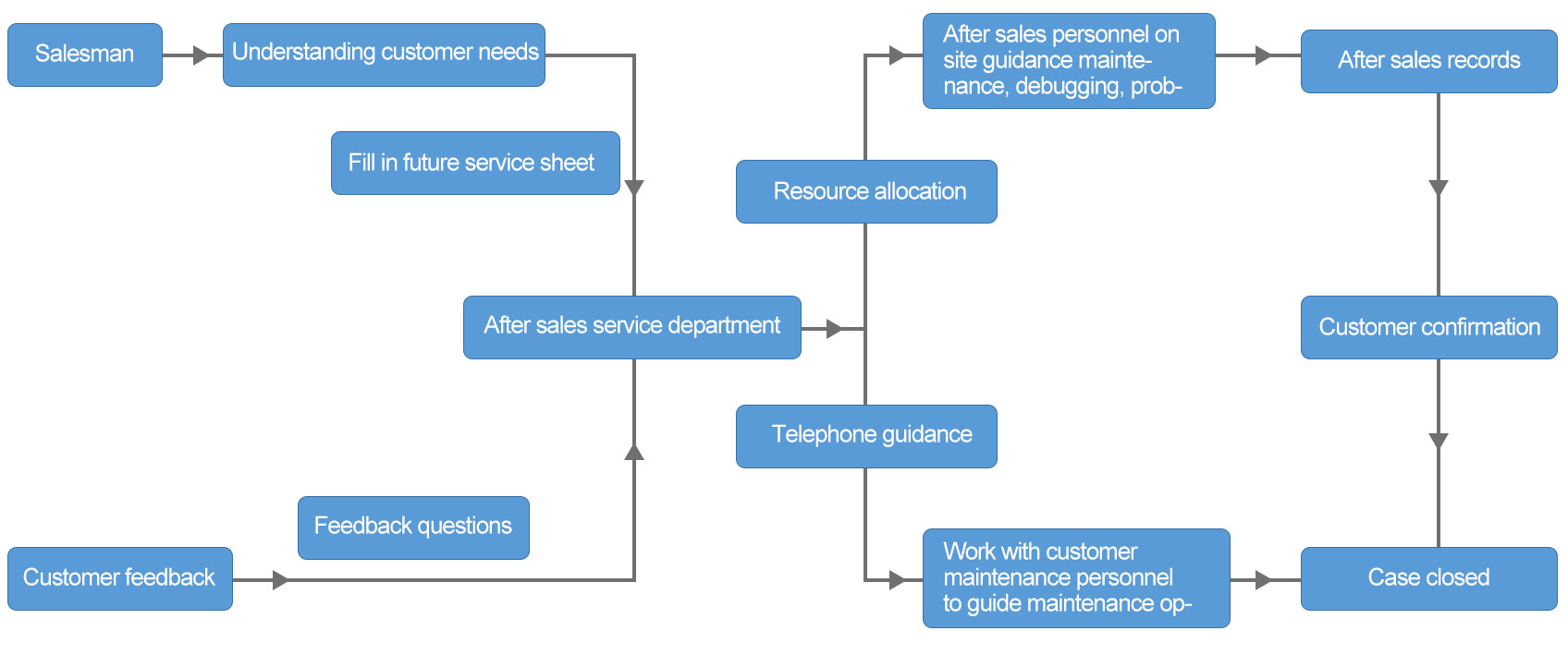Ozmbr intertrade australia pty ltd
AFTER-SALES SERVICE
HOME > SERVICE SUPPORT > AFTER-SALES SERVICE
I. Check the settings Before debugging, please make the following inspection preparations:
(1) Please reconfirm that the air pipe and the water outlet pipe are connected correctly;
(2) Confirm that the MBR pool has been cleaned up and there are no sharp objects and large impurities (may damage the original membrane);
(3) Open the air discharge valve to properly discharge the air in the membrane element;
(4) Put clean water (tap water or filtered water) to the operating level;
(5) Close the air discharge valve
Second, clean water debugging
(1) After the aeration blower is started, please confirm the aeration volume and aeration uniformity. Foam may be generated during clean water operation, which is usually related to the hydrophilic substance contained in the membrane element and does not affect the later operation;
(2) When one blower sends air to multiple membrane modules, the air volume supplied to each membrane module should be the same. If there is a significant difference, please check and adjust the aeration pipeline to make the aeration volume consistent;
(3) When debugging with clean water, please check the performance of the automatic control system;
(4) When debugging with clean water, please record membrane suction flux, transmembrane pressure difference, water temperature, etc.
3. Addition and domestication of sludge soil In order to start the submerged flat-panel MBR system as soon as possible and run with water, sludge inoculation and domestication are required. Please refer to the following steps to add seed mud:
(1) Please prepare activated sludge (preferably seed sludge for treating the same kind of wastewater). It is recommended to use sludge thickening tank or sludge dewatered by filter press;
(2) Filter the input through a screen (with a gap of 2mm or less) to remove impurities that may damage the membrane element;
(3) Appropriate addition of nutrients, flour, glucose, and yeast (100:5:1) during the domestication stage of seed mud;
(4) When the sludge concentration of the MBR tank reaches 3000mg/L~5000mg/L, the membrane module can be sucked;
(5) In the initial stage of the operation of the MBR system, the effluent flow rate is set at about 1/3 of the design flow. When the effluent is stable, the effluent flow will be slowly adjusted until it reaches the design value; (usually about one week)
(6) When the effluent quality reaches the standard, keep running at full load;
(7) When the amount of filtered water is stable, measure and record the initial transmembrane pressure difference of the membrane system.
The fouling of the orifice of the aeration pipe will cause uneven aeration and blockage of the membrane. In order to prevent the clogging of the membrane, please clean the aeration pipeline once a day (it is recommended to set an automatic valve to automatically clean the aeration pipeline).
When cleaning, open the air exhaust valve to release the pressure in the aeration tube to make the sludge flow back into the aeration tube, and discharge the sludge through the air flowing through the aeration tube.

(1) Stop filtering operation;
(2) Open the aeration valve. Through this operation, the sludge in the membrane immersion tank will flow back into the aeration pipe from the aeration hole and be discharged together with the air;
(3) Keep the discharge valve open for 3-5 minutes;
(4) Close the discharge valve and the cleaning is complete;
(5) Restart filtering.
2. Cleaning of MBR flat membrane elements
The continuous accumulation of membrane fouling will cause the transmembrane pressure difference to rise, and when it reaches a certain level, chemical (chemical) cleaning is required. The chemical (medicine) cleaning cycle and agent are determined as follows:
(1) When the transmembrane pressure difference under the same filtration flux is 35kPa higher than the initial stable operation, or once every 3 months (industrial wastewater is recommended to be cleaned once a month), choose the shorter time of the two for chemical treatment ( Chemical solution) cleaning;
(2) When the membrane pollutants are mainly biological organic pollution, the method of regular alkaline washing is used for control; when the pollution is mainly inorganic, the method of pickling is used for control.
| Pollutants | Name of drug | Drug concentration | Injection volume | Cleaning time |
| Organic compound | Sodium hypochlorite | 3000-5000mg/L | 3-5L/tablet | 8 hours or more |
| sodium hydroxide | 300-500mg/L | |||
| Inorganic matter | Citric acid or oxalic acid | 3000-5000mg/L | 3-5L/tablet | 5 hours |
Note: 0.8㎡/piece-3L/piece, 1.0㎡/piece-4L/piece, 1.5㎡/piece-5L/piece
Calculation of the amount of medicine: V=N×Y×C1÷C2×100%
V: The amount of total solvent (kg)
N: Number of membrane elements (pieces)
Y: The amount of liquid medicine needed to be injected into a single membrane element (L/piece)
C1: Solution concentration after dilution (mg/L)
C2: Solvent concentration before dilution (mg/L)
(1) Maintenance cleaning of membrane elements
1. Alkaline washing
a. Add sodium hypochlorite solution into the dosing barrel, and then add clean water to prepare a 3‰ (5‰) mixed liquid.
b. Stop filtering operation, close the water outlet valve, and close the fan aeration.
c. Open the dosing valve of the membrane module and inject all the medicines into the membrane module.
d. After injection, the immersion time should be over 8H.
e. After the soaking is complete, turn on the fan for aeration for more than 1-2H.
f. Open the water outlet valve, open the suction pump, and discharge the cleaning solution for pickling.
2. Pickling
a. Add oxalic acid or citric acid into the dosing barrel, and then add clear water to prepare a mixture of medicaments.
b. Stop filtering operation, close the water outlet valve, and close the fan aeration.
c. Open the dosing valve of the membrane module and inject the medicine into the membrane module.
d. After injection, turn on the fan for aeration, soak for more than 5 hours, and aerate the whole process.
e. After the soaking is completed, open the water outlet valve, open the suction pump, and start the filtration operation.
(2) Restorative cleaning of membrane elements
Recoverable cleaning of membrane elements must be equipped with a cleaning pool, aeration base must be installed and fixed, and aeration pipelines must be connected.
a. Stop filtering operation, close the water outlet valve and stop aeration;
b. Slowly open the liquid medicine valve and start to inject a given amount of liquid medicine;
c. After injection, leave it for a certain period of time;
d. After the alkali washing and soaking is completed, aerate for 1 hour, and maintain the aeration state when pickling and soaking;
e. Close the liquid medicine valve.
f. Configure the chemicals needed for cleaning in the cleaning pool;
g. Stop filtering operation, close the water outlet valve and stop aeration;
h. Remove the bolts of the flange between the water collection pipe and the water collection main pipe;
i. Lift the film box along the guide rail and put it into the cleaning tank;
j. Perform aeration cleaning on the membrane box and soak it for the required time;
l. After cleaning, lift the membrane box to restore it, and tighten the bolts of the flange between the water collection pipe and the water collection main pipe;
m. Start aeration, open the water outlet valve, and restart the filtration operation.
(3) Offline physical cleaning of membrane elements
When the problem cannot be solved by the recovery cleaning of the membrane element, the membrane element needs to be taken out of the membrane module, placed on a flat ground or in a clean container, and washed with a pressure water jet or soft sponge to scrub the membrane surface.



